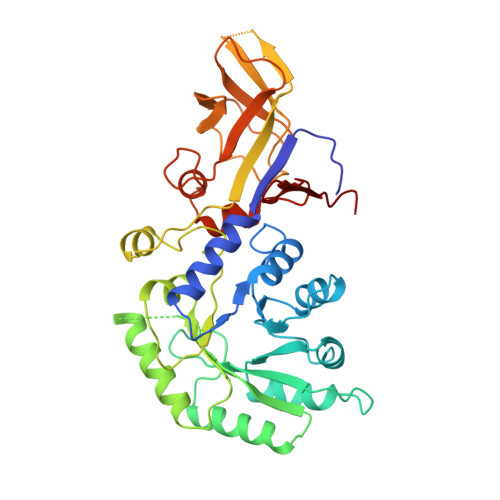Structural Features and Kinetic Characterization of Alanine Racemase from Staphylococcus Aureus (Mu50)
Scaletti, E.R., Luckner, S.R., Krause, K.L.(2012) Acta Crystallogr D Biol Crystallogr 68: 82
- PubMed: 22194336
- DOI: https://doi.org/10.1107/S0907444911050682
- Primary Citation of Related Structures:
4A3Q - PubMed Abstract:
Staphylococcus aureus is an opportunistic Gram-positive bacterium which causes a wide variety of diseases ranging from minor skin infections to potentially fatal conditions such as pneumonia, meningitis and septicaemia. The pathogen is a leading cause of nosocomial acquired infections, a problem that is exacerbated by the existence of methicillin- and glycopeptide antibiotic-resistant strains which can be challenging to treat. Alanine racemase (Alr) is a pyridoxal-5'-phosphate-dependent enzyme which catalyzes reversible racemization between enantiomers of alanine. As D-alanine is an essential component of the bacterial cell-wall peptidoglycan, inhibition of Alr is lethal to prokaryotes. Additionally, while ubiquitous amongst bacteria, this enzyme is absent in humans and most eukaryotes, making it an excellent antibiotic drug target. The crystal structure of S. aureus alanine racemase (Alr(Sas)), the sequence of which corresponds to that from the highly antibiotic-resistant Mu50 strain, has been solved to 2.15 Å resolution. Comparison of the Alr(Sas) structure with those of various alanine racemases demonstrates a conserved overall fold, with the enzyme sharing most similarity to those from other Gram-positive bacteria. Structural examination indicates that the active-site binding pocket, dimer interface and active-site entryway of the enzyme are potential targets for structure-aided inhibitor design. Kinetic constants were calculated in this study and are reported here. The potential for a disulfide bond in this structure is noted. This structural and biochemical information provides a template for future structure-based drug-development efforts targeting Alr(Sas).
Organizational Affiliation:
Department of Biochemistry, University of Otago, Dunedin, New Zealand.

















